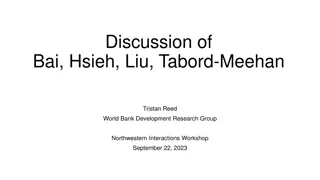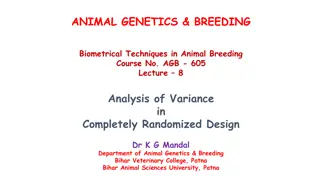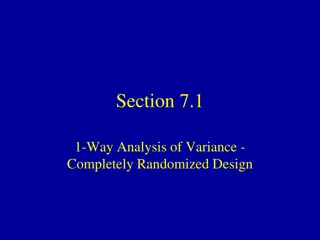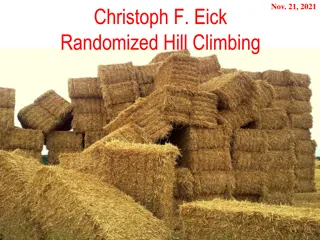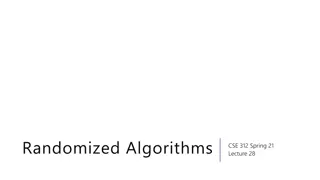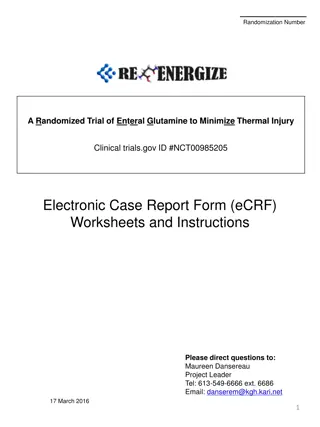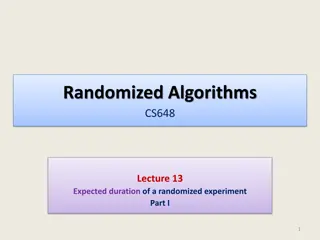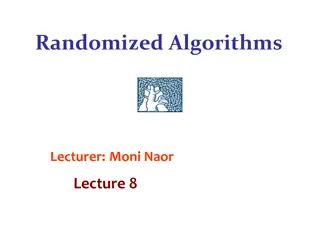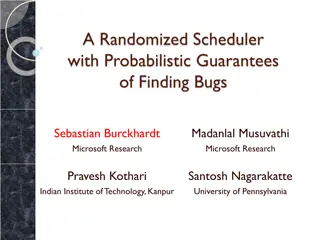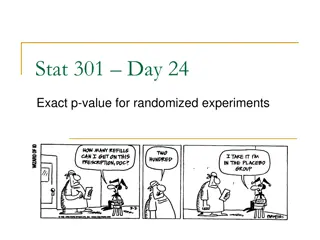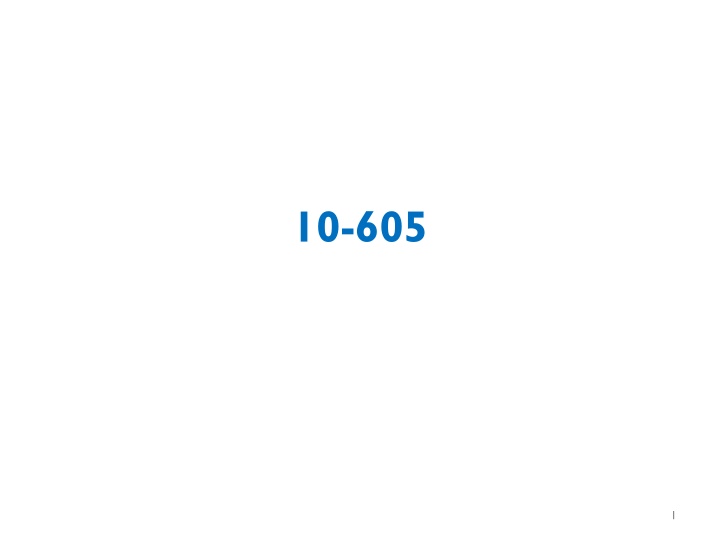
Insights into Memory Optimization using Hash Tricks
Discover the power of hash tricks in optimizing memory usage for streaming learning algorithms. Explore concepts like lazy L2, hashing, parallelization, and more. Learn how hashing random data structures and variants like Bloom filters can make a significant impact on memory efficiency.
Download Presentation

Please find below an Image/Link to download the presentation.
The content on the website is provided AS IS for your information and personal use only. It may not be sold, licensed, or shared on other websites without obtaining consent from the author. If you encounter any issues during the download, it is possible that the publisher has removed the file from their server.
You are allowed to download the files provided on this website for personal or commercial use, subject to the condition that they are used lawfully. All files are the property of their respective owners.
The content on the website is provided AS IS for your information and personal use only. It may not be sold, licensed, or shared on other websites without obtaining consent from the author.
E N D
Presentation Transcript
10-605 1
The course so far Map-reduce and parallel counting Streaming learning algorithms some tricks like lazy L2 and hashing Parallelizing streaming learning algorithms param mixing for clusters vectorization and minibatches for GPUs Now: Some more tricks like hashing randomized data structures aka sketches these can make a huge difference in memory in many cases 2
Hash Trick - Insights Save memory: don t store hash keys Allow collisions even though it distorts your data some Let the learner (downstream) take up the slack 4
An example 2^26 entries = 1 Gb @ 8bytes/weight 5
MOTIVATING BLOOM FILTERS: VARIANT OF THE HASH TRICK 6
A variant of feature hashing Hash each feature multiple times with different hash functions Now, each w has k chances to not collide with another useful w An easy way to get multiple hash functions Generate some random strings s1, ,sL Let the k-th hash function for w be the ordinary hash of concatenation w sk V[h]= j:hash( j sk)%R=h k j xi 7
A variant of feature hashing a!=b are binary vectors Hash each feature multiple times with different hash functions Now, each w has k chances to not collide with another useful w An easy way to get multiple hash functions Generate some random strings s1, ,sL Let the k-th hash function for w be the ordinary hash of concatenation w sk V[h]= j:hash( j sk)%R=h V(a) 1 0 1 1 0 1 0 1 1 1 1 0 0 0 0 0 1 1 2 0 V(a) V(b) 1 1 0 0 1 1 0 0 V(b) 1 1 1 0 k j xi 8
A variant of feature hashing Why would this work? k V[h]= j xi j:hash( j sk)%R=h Claim: with 100,000 features and 100,000,000 buckets: k=1 Pr(any feature duplication) 1 k=2 Pr(any feature duplication) 0.4 k=3 Pr(any feature duplication) 0.01 9
Hash Trick - Insights Save memory: don t store hash keys Allow collisions even though it distorts your data some Let the learner (downstream) take up the slack Bloom filters Bloom filters are another famous trick that exploits these insights . 10
Bloom filters Interface to a Bloom filter BloomFilter(int maxSize, double p); void bf.add(String s); // insert s bool bd.contains(String s); // If s was added return true; // else with probability at least 1-p return false; // else with probability at most p return true; I.e., a noisy set where you can test membership (and that s it) 12
Bloom filters An implementation Allocate M bits, bit[0] ,bit[1-M] Pick K hash functions hash(1,2),hash(2,s), . E.g: hash(i,s) = hash(s+ randomString[i]) To add string s: For i=1 to k, set bit[hash(i,s)] = 1 To check contains(s): For i=1 to k, test bit[hash(i,s)] Return true if they re all set; otherwise, return false We ll discuss how to set M and K soon, but for now: Let M = 1.5*maxSize // less than two bits per item! Let K = 2*log(1/p) // about right with this M 13
Bloom filters 0 0 0 0 0 0 0 0 0 0 bf.add( fred flintstone ): h1 h2 h3 0 1 1 0 0 0 0 1 0 0 bf.add( barney rubble ): h1 h2 h3 1 1 1 0 0 1 0 1 0 0 14
Bloom filters 1 1 1 0 0 1 0 1 0 0 bf.contains ( fred flintstone ): h1 h2 1 1 1 0 0 1 0 1 0 0 bf.contains( barney rubble ): h1 h2 h3 1 1 1 0 0 1 0 1 0 0 15
Bloom filters 1 1 1 0 0 1 0 1 0 0 bf.contains( wilma flintstone ): h1 h3 h2 1 1 1 0 0 1 0 1 0 0 bf.contains( wilma flintstone ): h1 h2 h3 1 1 1 0 0 1 0 1 0 0 16
Bloom filters: analysis Analysis (m bits, k hashers): Assume hash(i,s) is a random function Look at Pr(bit j is unset after n add s): and Pr(collision) = Pr(not all k bits set) f(m,n,k) = . fix m and n and minimize k: k = 17
Bloom filters Analysis: Plug optimal k=m/n*ln(2) back into Pr(collision): f(m,n) = Now we can fix any two of p, n, m and solve for the 3rd: E.g., the value for m in terms of n and p: 18
Bloom filters Interface to a Bloom filter BloomFilter(int maxSize /* n */, double p); void bf.add(String s); // insert s bool bd.contains(String s); // If s was added return true; // else with probability at least 1-p return false; // else with probability at most p return true; I.e., a noisy set where you can test membership (and that s it) 19
What do you do with a Bloom Filter? 21
Some uses of Bloom filters An example application Finding items in sharded data Easy if you know the sharding rule Harder if you don t (like Google n-grams) 22
Some Uses of Bloom filters An example application Finding items in sharded data Easy if you know the sharding rule Harder if you don t (like Google n-grams) Simple idea: Build a BF of the contents of each shard To look for key, load in the BF s one by one, and search only the shards that probably contain key Analysis: you won t miss anything, you might look in some extra shards You ll hit O(1) extra shards if you set p=1/#shards 23
Some Uses of Bloom filters An example application discarding singleton features from a classifier Scan through data once and check each w: if bf1.contains(w): bf2.add(w) else bf1.add(w) Now: bf1.contains(w) w appears >= once bf2.contains(w) w appears >= 2x Then train, ignoring words not in bf2 24
Some Uses of Bloom filters An example application discarding rare features from a classifier seldom hurts much, can speed up experiments Scan through data once and check each w: if bf1.contains(w): if bf2.contains(w): bf3.add(w) else bf2.add(w) else bf1.add(w) Now: bf2.contains(w) w appears >= 2x bf3.contains(w) w appears >= 3x Then train, ignoring words not in bf3 25
A variant of feature hashing Hash each feature multiple times with different hash functions Now, each w has k chances to not collide with another useful w Get multiple hash functions as in Bloom filters Part Bloom filter, part hash kernel but predates either, called count-min sketch -- Cormode and Muthukrishnan 27
Bloom filters An implementation Allocate M bits, bit[0] ,bit[1-M] Pick K hash functions hash(1,2),hash(2,s), . E.g: hash(i,s) = hash(s+ randomString[i]) To add string s: For i=1 to k, set bit[hash(i,s)] = 1 To check contains(s): For i=1 to k, test bit[hash(i,s)] Return true if they re all set; otherwise, return false We ll discuss how to set M and K soon, but for now: Let M = 1.5*maxSize // less than two bits per item! Let K = 2*log(1/p) // about right with this M 28
Bloom Filter Count-min sketch An implementation Allocate a matrix CM with d rows, w columns Pick d hash functions h1(s),h2(s), . To increment counter A[s] for s by c For i=1 to d, set CM[i, hash(i,s)] += c To retrieve value of A[s]: For i=1 to d, retrieve M[i, hash(i,s)] Return minimum minimum of these values Similar idea as Bloom filter: if there are d collisions, you return a value that s too large; otherwise, you return the correct value. Question: what does this look like if d=1? 29
from: Minos Garofalakis CM Sketch Structure +c h1(s) d=log 1/ +c <s, +c> +c +c hd(s) w = 2/ Each string is mapped to one bucket per row Estimate A[j] by taking mink { CM[k,hk(j)] } Errors are always over-estimates Analysis: d=log 1/ , w=2/ error is usually less than e||A||1 i.e. with prob > 1- 30
from: Minos Garofalakis <s, +c> c c You can find the sum of two sketches by doing element-wise summation c c <t, +d> d d Also, you can compute a weighted sum of MC sketches + d d Same result as adding <s,+c> and then <t,+d> to an empty sketch d c c+d d c d c 31
from: Minos Garofalakis CM Sketch Guarantees [Cormode, Muthukrishnan 04] CM sketch guarantees approximation error on point queries less than ||A||1 in space O(1/ log 1/ ) Probability of more error is less than 1- This is sometimes enough: Estimating a multinomial: if A[s] = Pr(s| ) then ||A||1 = 1 Multiclass classification: if Ax[s] = Pr(x in class s) then ||Ax||1 is probably small, since most x s will be in only a few classes 32
from: Minos Garofalakis CM Sketch Guarantees [Cormode, Muthukrishnan 04] CM sketch guarantees approximation error on point queries less than ||A||1 in space O(1/ log 1/ ) CM sketches are also accurate for skewed values---i.e., only a few entries s with large A[s] 33
What do you do with a count-min sketch? 34
An Application of a Count-Min Sketch Problem: find the semantic orientation of a work (positive or negative) using a large corpus. Idea: positive words co-occur more frequently than expected near positive words; likewise for negative words so pick a few pos/neg seeds and compute x appears near y 35
An Application of a Count-Min Sketch x appears near y Example: Turney, 2002 used two seeds, excellent and poor In general, SO(w) can be written in terms of logs of products of counters for w, with and without seeds 36
An Application of a Count-Min Sketch Use 2B counters, 5 hash functions, near means a 7-word window, GigaWord (10 Gb) and GigaWord + Web news 50 Gb) 37
An Application of a Count-Min Sketch CM-CU: CM with conservative update - for <j,+c> increment counters just enough to make the new estimate for j grow by c 38
Deep Learning and Sketches 39
ICLR 2017 40
ICLR 2017 summation w/o nonlinearity weights and reLU compute the AND that decodes x24 Claim: for any w there is a one-layer neural network that can compute* <w,x> using as input a Bloom-filter sketch** of x, if x is a k-hot binary vector over d dimensions. w24 * with prob 1 ? ** of size O(ek log | ? |0/?) 41
ICLR 2017 weights and reLU compute the AND that decodes x24 now weights and reLU compute x24*x29 Also: weights in network are between 0 and 1 only O(ek log | ? |0/?) of the weights are non- zero you can express more complex functions with a few more non-zero weights e.g. polynomial kernels we can learn these networks using an L1 regularizer 42
RCV1, 4 categories, 113k dimensions, most examples are 120-sparse mt is sketch size 3 values of L1- regularizer are used 43
entity-tagging task with very large feature vocabulary mt is sketch size 3 values of L1- regularizer are used compared to feature hashing 44
ICLR 2017 What if you are mapping many inputs to many possible outputs? Song recommendation: output is a song Language modeling: output is a word 45
50k possible books What if you are mapping many inputs to many possible outputs? Book recommendation: output is a book Language modeling: output is a word Solution: output a sketch! 46
X X To score y, addup the scores of the codes for y Softmax predicts the BF encoding bits What if you are mapping many inputs to many possible outputs? Book recommendation: output is a book Language modeling: output is a word Solution: output a sketch! 47


